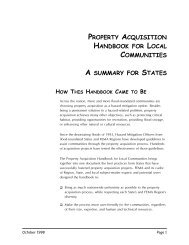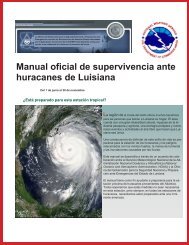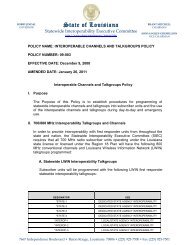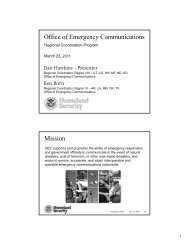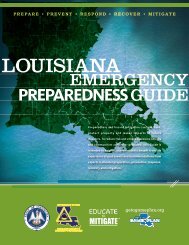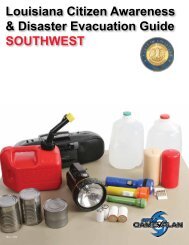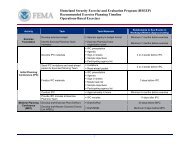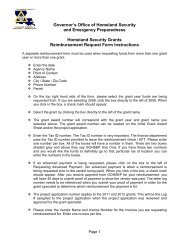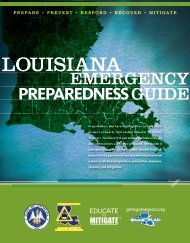Before the Federal Communications Commission Washington, D.C. ...
Before the Federal Communications Commission Washington, D.C. ...
Before the Federal Communications Commission Washington, D.C. ...
- No tags were found...
You also want an ePaper? Increase the reach of your titles
YUMPU automatically turns print PDFs into web optimized ePapers that Google loves.
<strong>Federal</strong> <strong>Communications</strong> <strong>Commission</strong> FCC 02-64D. Description of Reporting, Recordkeeping, and O<strong>the</strong>r Compliance RequirementsThe rules adopted in this Report and Order impose no new reporting, recordkeeping or compliancerequirements on broadcast stations and cable systems, including wireless cable systems. This Report andOrder adopts a number of new EAS event codes and location codes which may be used by broadcaststations and cable systems that participate voluntarily in state and local EAS activities. Broadcaststations and cable systems will not be required to upgrade <strong>the</strong>ir existing EAS equipment to add <strong>the</strong>se newevent and location codes. Ra<strong>the</strong>r, <strong>the</strong>y may upgrade <strong>the</strong>ir existing EAS equipment to add <strong>the</strong>se newcodes on a voluntary basis until <strong>the</strong> equipment is replaced. All existing and new models of EASequipment manufactured after August 1, 2003 will be required to be capable of receiving andtransmitting <strong>the</strong>se new codes.The Report and Order also makes revisions to <strong>the</strong> EAS rules which will reduce compliance burdens onbroadcast stations and cable systems. The revised rules permit, but do not require, broadcast stations andcable systems to modify <strong>the</strong>ir existing EAS equipment to selectively display and log EAS messages thatcontain state and local event codes. This selectively displaying and logging feature will relieve broadcaststations and cable systems from <strong>the</strong> burden of logging unwanted EAS messages, e.g., messages that donot apply to <strong>the</strong>ir service area or messages concerning events which <strong>the</strong>y have decided not to transmit. Inaddition, <strong>the</strong> revised rules increase <strong>the</strong> period within which broadcast stations and cable systems mustretransmit <strong>the</strong> Required Monthly Test (“RMT”) from 15 minutes to 60 minutes. This revision willprovide broadcast stations and cable systems, including smaller stations and systems, more flexibility toinsert <strong>the</strong> RMT message into <strong>the</strong>ir program schedules without disrupting programming. Additionally, <strong>the</strong>rules are revised to require that <strong>the</strong> modulation level of EAS codes be at <strong>the</strong> maximum possible level, butin no case less than 50% of full channel modulation limits. This revision brings <strong>the</strong> EAS rules intoalignment with <strong>the</strong> modulation levels currently obtainable by broadcast stations.E. Steps Taken to Minimize Significant Economic Impact on Small Entities, and SignificantAlternatives ConsideredThe RFA requires an agency to describe any significant alternatives that it has considered in reaching itsapproach, which may include <strong>the</strong> following four alternatives (among o<strong>the</strong>rs): (1) <strong>the</strong> establishment ofdiffering compliance or reporting requirements or timetables that take into account <strong>the</strong> resourcesavailable to small entities; (2) <strong>the</strong> clarification, consolidation, or simplification of compliance orreporting requirements under <strong>the</strong> rule for small entities; (3) <strong>the</strong> use of performance ra<strong>the</strong>r than designstandards; and (4) an exemption from coverage of <strong>the</strong> rule, or any part <strong>the</strong>reof, for such small entities. 237The Report and Order reduces compliance requirements for small entities by exempting satellite/repeaterbroadcast stations which rebroadcast 100% of <strong>the</strong> programming of <strong>the</strong>ir hub station from <strong>the</strong> requirementto install EAS equipment; authorizing cable systems and wireless cable systems serving fewer than 5,000subscribers to meet <strong>the</strong> October 1, 2002 compliance deadline by installing certified EAS decoders, ifsuch decoders become available, ra<strong>the</strong>r than both encoders and decoders; and delaying <strong>the</strong> requirementthat LPFM stations install certified EAS decoders until one year after <strong>the</strong> <strong>Commission</strong> publishes in <strong>the</strong><strong>Federal</strong> Register a public notice indicating that at least one decoder has been certified.In adopting new event codes and location codes in this Report and Order, we took into account concernsraised by commenters that a requirement to update existing EAS equipment to add <strong>the</strong> new codes couldimpose a financial burden on some broadcast stations and cable systems, particularly smaller entities.2375 U.S.C. § 603(c)(1) – (c)(4).55



